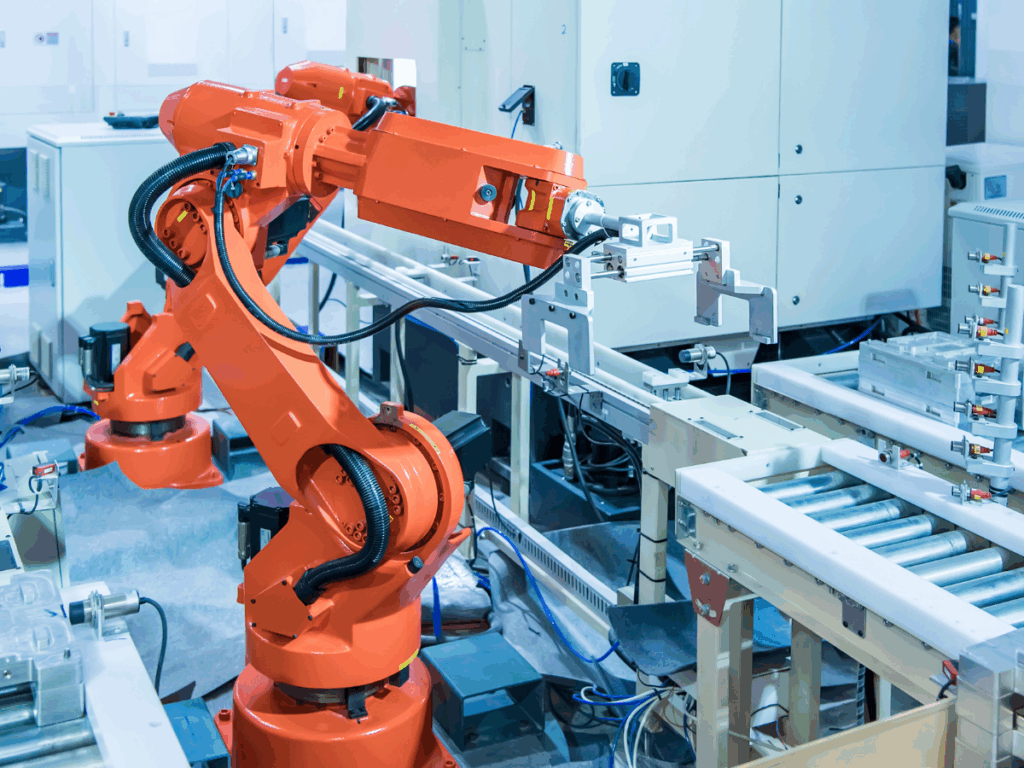How to Automate Pick and Place
If your business is like most, you’re likely being asked to increase production, but finding it difficult to retain the staff to make that happen. Pick-and-place automation is a clear solution to this problem because robots and cobots efficiently and accurately perform the essential, but repetitive task of moving components from one area to another, helping offset labor shortages while boosting productivity.
This guide will discuss the equipment, selection criteria and integration steps to help you find the best solution for your pick-and-place process.

What is Pick-and-Place Automation?
Pick-and-place solutions automate the process of picking up objects and moving them to another location to relieve workers from this dull and efficiency-draining task so they can focus on more complex, value-added jobs on the plant floor.
The benefits of pick-and-place robots include:
- Increased speed and throughput: Robots move at high speeds, which reduces bottlenecks.
- Consistent accuracy: Programmed tasks are performed without deviations, reducing errors, scrap and waste.
- Improved quality: Precision robotic movements lead to higher quality finished products, whether in assembly, inspection or packaging.
- Enhanced safety: Automating tasks that involve repetitive bending, twisting and lifting prevents worker fatigue and injuries.
Common Applications for Pick-and-Place Robots
Traditional pick-and-place automation performs repetitive tasks with high levels of consistency, accuracy and efficiency and the addition of vision systems and advanced end-of-arm tooling have expanded the use of pick-and-place robots into many applications where they significantly increase throughput.
Ideal applications for pick-and-place robots include:
- Part sorting: The addition of vision allows pick-and-place robots to sort objects by size, shape and color.
- Assembly: Pick-and-place robots accurately but gently select components from multiple locations to construct larger assemblies.
- Bin picking: These robots excel at selecting parts from bins and placing them onto a conveyor or into a kit.
- Packaging: Pick-and-place automation can place products into packages or move packed items onto pallets.
Types of Pick-and-Place Automation Solutions
There are three types of pick-and-place technologies available. While the primary use typically dictates which solution is right for an application, factors such as space, budget and the need for human collaboration also play a role. Here we explain each solution.
Industrial Robots
Traditional industrial robots are ideal for high-speed or heavy-payload applications. While SCARA, articulated and Cartesian robots are successfully used for pick-and-place operations, Delta robots are often the choice for high-speed applications. Keep in mind that industrial robots will require the installation of safety guarding and other safety devices to prevent injuries to workers in the area.
Collaborative Robots
Collaborative robots, or cobots, are designed with built-in safety features such as force-limiting sensors and stopped-state monitoring so that they may be safely used alongside human workers. Cobots can offer smaller footprints and may not require the use of bulky safety guarding, making them a great choice for facilities with space limitations.
Pneumatic Pick-and-Place Actuators
Pneumatic pick-and-place actuators are a cost-effective option for simpler, less complex pick-and-place functions. Capable of performing both linear and rotary movements, these pneumatic devices are more limited in application than pick-and-place robots or cobots.
How to Choose the Right Pick-and-Place Solution
To ensure the selected technology meets the requirements of your operation, it’s important to answer key questions about the application and make certain they align with the robot’s specifications.
Payload: What is the combined weight of the heaviest object and the end-of-arm tooling? The robot must be able to support this payload.
Reach: What is the maximum vertical and horizontal distance the robot needs to cover, including any obstacles around which the robot must maneuver? Ensure the robot offers this reach.
Speed and precision: How many cycles per minute are required to meet your production goals and how precise must the robot be? For example, SCARA robots are fast, but 6-axis robots offer more dexterity.
Space/Footprint: How much floor space is available? Cobots and pneumatic solutions typically require less space than traditional industrial robots outfitted with cages and safety guarding.
Axes/Degrees of Movement: Does the task require simple linear motion or complex twisting and turning manipulations? More axes provide more degrees of movement for more complex operations.
Repeatability: How precisely must the robot repeat the same action? This is an essential criterion for high-quality assembly or inspection operations.
Budget: What is the available budget? Pneumatic actuators are the most cost effective, followed by cobots and then industrial robots.
5 Key Steps for Successful Integration
Integrating a pick-and-place robot is manageable, but enlisting an experienced and knowledgeable automation partner will simplify the process and contribute to the success of the project. Below are five steps for a successful pick-and-place automation project.
Step 1: Define the Process and Project Goals
Start by identifying the process that will offer the greatest reward. Look for operations that currently experience bottlenecks and safety issues. It’s best to start with small, less complex projects.
Step 2: Engineer the Solution and Select Equipment
After answering the questions above, choose a robot that meets the requirements of the application. Identify necessary accessories, such as grippers, vision systems, stands and guarding.
Step 3: Plan the Workspace and Installation
Prepare the workspace. Make certain that the foundation is strong and stable enough to support the robot while it’s in motion and that necessary electrical hook ups are in place. A risk assessment must be conducted to ensure that the installation meets safety regulations. For industrial robots, plan for Human Robot Collaboration (HRC) spaces with appropriate safety guarding and safety sensors.
Step 4: Integrate the Robot with Other Systems
Plan how the robot will interface with existing equipment like CNC machines or compressed air and that it can communicate with software and control systems. Integration can be complex, so it is advisable to partner with a specialist to ensure that all solutions work together without any glitches.
Step 5: Plan for Training, Service and Support
Train operators and maintenance technicians who will interact with the robot. Establish a service plan in advance. Having 24/7 support available significantly reduces costly downtime.
Common Problems with Pick-and-Place Automation and How to Solve Them
Addressing common issues with the help of an experienced automation partner can help prevent or resolve problems.
Problem: Poor performance due to incorrect robot selection
Talk with the experts at JHFOSTER to ensure that the selected robot, payload and speed satisfy the application requirements.
Problem: Complex integration causes costly delays
Create a detailed integration plan from the get-go. Working with an experienced automation provider ensures that interfacing with existing equipment is handled properly and efficiently.
Problem: Safety risks in shared workspaces
Perform a mandatory risk assessment. Either install certified safety guarding around industrial robots or select a collaborative robot designed for safe operation alongside human workers.
The Future of Pick-and-Place Automation
As more manufacturers enlist the help of pick-and-place automation to boost throughput and offset labor shortages, the addition of new technologies provides even more benefits.
Collaborative and mobile robots are becoming more common in these applications because their built-in safety features permit them to work in close collaboration with human employees and they are a cinch to program, making them more flexible in a variety of applications and accessible to more businesses.
The use of vision systems and AI allows pick-and-place robots to “see” and “think,” which opens the door for use in applications where they must sort by color, size or shape and for inspection purposes.
Your Partner in Pick-and-Place Automation
As your automation partner, JHFOSTER provides support through the entire lifecycle of your solution, from evaluation to design to integration to support. Ready to start working faster, smarter and more efficiently? Contact our automation specialists today to find the best pick-and-place solution for your application.
